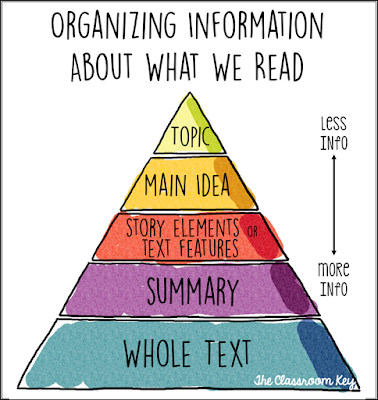 Hi there! It's Hannah from The Classroom Key. Do you ever feel like your kids are drowning in all the reading strategies and terms you have taught them? When you ask for the main idea of a text, do they just give you a one word answer? Or do they launch into a full summary?
Hi there! It's Hannah from The Classroom Key. Do you ever feel like your kids are drowning in all the reading strategies and terms you have taught them? When you ask for the main idea of a text, do they just give you a one word answer? Or do they launch into a full summary? One of the first reading strategies I teach is finding the main idea. Then later we also talk about summarizing... and along with summarizing comes identifying story elements... and some assessments ask students to identify the topic of a text... and on, and on! Geeze, my head is spinning already!
What your reading series teacher's guide (if you even have one!) won't tell you, is that kids need a way to organize those strategies and terms in their heads! It may be that your students are good comprehenders but they're getting lost in the terminology. This can be especially problematic on assessments when you can't prompt them for less or more information.
Enter: a solution! This chart shows how some of the most common reading comprehension terms and strategies relate to one another.
Notice the bottom of the pyramid is the whole text. This is the maximum amount of information. Next is a summary which offers a little less information. Up higher is the major story elements (characters, setting, problem, and solution) or content from text features (for nonfiction) which is less information still. Then comes the main idea which is probably just a sentence or two. Finally at the very top is the topic which would only be one or two words.
If you ask your students to identify the main idea and they start launching into a summary, draw their attention to this chart to define the difference. Conversely, if you ask for the main idea of a text and a student says "owls," you can point out how a one word answer would be the topic, but a main idea statement gives a little bit more information.
Click the picture to download the chart and also a black and white version you can copy for students!
Thanks for stopping by!
Hannah
Clip art in this post comes from the talented Sarah Pecorino.




I love that pyramid as a visual reminder for students!
ReplyDeleteStorie
Stories by Storie
I'm a very visual person-I love this! Thanks for sharing!
ReplyDeleteDebbi